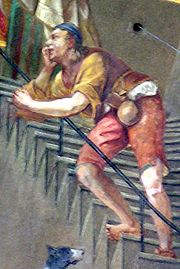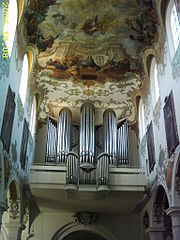
Johannes Zick
Encyclopedia


Germans
The Germans are a Germanic ethnic group native to Central Europe. The English term Germans has referred to the German-speaking population of the Holy Roman Empire since the Late Middle Ages....
painter of fresco
Fresco
Fresco is any of several related mural painting types, executed on plaster on walls or ceilings. The word fresco comes from the Greek word affresca which derives from the Latin word for "fresh". Frescoes first developed in the ancient world and continued to be popular through the Renaissance...
es in southern Germany
Germany
Germany , officially the Federal Republic of Germany , is a federal parliamentary republic in Europe. The country consists of 16 states while the capital and largest city is Berlin. Germany covers an area of 357,021 km2 and has a largely temperate seasonal climate...
and active during the Baroque
Baroque
The Baroque is a period and the style that used exaggerated motion and clear, easily interpreted detail to produce drama, tension, exuberance, and grandeur in sculpture, painting, literature, dance, and music...
period. He was the father of painter Januarius Zick
Januarius Zick
Johann Rasso Januarius Zick was a painter and architect. He is considered to be one of the main masters of the Late-Baroque.-Life:...
and considered to be an important master of the Late Baroque.
Life
Johannes Zick was born in 1702 in LachenLachen, Germany
Lachen is a municipality in the district of Unterallgäu in Bavaria, Germany....
, part of the territory of the Prince-Abbot
Prince-abbot
A Prince-Abbot is a title for a cleric who is a Prince of the Church , in the sense of an ex officio temporal lord of a feudal entity, notably a State of the Holy Roman Empire. The secular territory ruled by the head of an abbey is known as Prince-Abbacy or Abbey-principality...
of Kempten
Kempten
Kempten can refer to:* Kempten im Allgäu, a town in Bavaria, Germany* Kempten ZH, a district of the town of Wetzikon in the canton of Zurich, Switzerland* Kempton Park, Gauteng, a city in South Africa which was named after Kempten in Bavaria...
in the Unterallgäu
Unterallgäu
Unterallgäu is a Kreis in the southwestern part of Bavaria, Germany. Neighboring districts are Neu-Ulm, Günzburg, Augsburg, Ostallgäu, Oberallgäu, and the districts Ravensburg und Biberach in Baden-Württemberg. The district-free city Memmingen in the west of the district is nearly surrounded by...
in modern-day Bavaria
Bavaria
Bavaria, formally the Free State of Bavaria is a state of Germany, located in the southeast of Germany. With an area of , it is the largest state by area, forming almost 20% of the total land area of Germany...
, where he started his career as a blacksmith
Blacksmith
A blacksmith is a person who creates objects from wrought iron or steel by forging the metal; that is, by using tools to hammer, bend, and cut...
in his father's workshop. From 1721 to 1724, he was apprenticed to the Konstanz
Konstanz
Konstanz is a university city with approximately 80,000 inhabitants located at the western end of Lake Constance in the south-west corner of Germany, bordering Switzerland. The city houses the University of Konstanz.-Location:...
court painter
Court painter
A court painter was an artist who painted for the members of a royal or noble family, sometimes on a fixed salary and on an exclusive basis where the artist was not supposed to undertake other work. Especially in the late Middle Ages, they were often given the office of valet de chambre...
Jacob Carl Stauder. They both painted the frescoes on the ceiling of the church Mariahilf in Munich
Munich
Munich The city's motto is "" . Before 2006, it was "Weltstadt mit Herz" . Its native name, , is derived from the Old High German Munichen, meaning "by the monks' place". The city's name derives from the monks of the Benedictine order who founded the city; hence the monk depicted on the city's coat...
.
Zick moved with his family to Munich in 1728 where he was appointed court painter to Prince Bishop Duke
Duke
A duke or duchess is a member of the nobility, historically of highest rank below the monarch, and historically controlling a duchy...
Johann Theodor of Bavaria
Johann Theodor of Bavaria
John Theodore of Bavaria , a son of Elector Maximilian II Emanuel of Bavaria and Teresa Kunegunda Sobieska, and a grandson of King John III Sobieski of Poland...
. Johannes Zick's further development as a painter of frescoes was stimulated by the Asam brothers
Asam brothers
The Asam Brothers were sculptors, workers in stucco, painters, and architects, who worked mostly together and in southern Germany...
, who were active in Munich at the time.
Johannes Zick worked extensively in Upper Swabia
Upper Swabia
Upper Swabia is a region in Germany in the federal states of Baden-Württemberg and Bavaria. The name refers to the area between the Swabian Alb, Lake Constance and the Lech...
between 1744 and 1749. Due to his employment in Upper Swabia, his family followed him there in 1746, living either in Schussenried
Bad Schussenried
Bad Schussenried is a town in Upper Swabia in the district of Biberach, Baden-Württemberg, Germany.It lies on the Upper Swabian Baroque Route.Schussenried Abbey, a former monastery founded in 1183, is located in Bad Schussenried...
or in Biberach an der Riß
Biberach an der Riß
Biberach is a town in the south of Germany. It is the capital of Biberach district, in the Upper Swabia region of the German state of Baden-Württemberg...
. In 1746, he painted the frescoes on the ceiling of the central nave
Nave
In Romanesque and Gothic Christian abbey, cathedral basilica and church architecture, the nave is the central approach to the high altar, the main body of the church. "Nave" was probably suggested by the keel shape of its vaulting...
in St. Martin's Church
St. Martin's Church, Biberach
St. Martin's Church, Biberach is a church in Biberach an der Riß, in the Upper Swabia region of the German state of Baden-Württemberg. It is the oldest still active Simultaneum or shared church in Germany.-History:...
in Biberach an der Riß
Biberach an der Riß
Biberach is a town in the south of Germany. It is the capital of Biberach district, in the Upper Swabia region of the German state of Baden-Württemberg...
and, following his design, the other naves were reconstructed and painted with frescoes in 1747.
Around 1750, he moved to Würzburg
Würzburg
Würzburg is a city in the region of Franconia which lies in the northern tip of Bavaria, Germany. Located at the Main River, it is the capital of the Regierungsbezirk Lower Franconia. The regional dialect is Franconian....
where he painted the frescoes in the so-called garden room at the Würzburg Residence
Würzburg Residence
The Würzburg Residence is a palace in Würzburg, southern Germany. Johann Lukas von Hildebrandt and Maximilian von Welsch, representants of the Austrian/South German Baroque were involved in the construction, as well as Robert de Cotte and Germain Boffrand, who were followers of the French Style...
, the dwelling place of the Prince Bishop of Würzburg. For nine years, between 1751 and 1759, he furnished the residence of the Prince Bishops of Speyer
Diocese of Speyer
The Diocese of Speyer is a diocese of the Catholic Church in Germany. The diocese is located in the South of the Rhineland-Palatinate and comprises also the Saarpfalz district in the east of the Saarland. The bishop's see is in the Palatinate city of Speyer.The current bishop is Karl-Heinz...
in Bruchsal
Bruchsal
Bruchsal is a city at the western edge of the Kraichgau, approximately 20 km northeast of Karlsruhe in the state of Baden-Württemberg, Germany...
with paintings. Johannes Zick died in Würzburg in 1762.
Works
- 1736 - Decoration of vaultVault (architecture)A Vault is an architectural term for an arched form used to provide a space with a ceiling or roof. The parts of a vault exert lateral thrust that require a counter resistance. When vaults are built underground, the ground gives all the resistance required...
and altarAltarAn altar is any structure upon which offerings such as sacrifices are made for religious purposes. Altars are usually found at shrines, and they can be located in temples, churches and other places of worship...
in the church of St. John the Baptist, BergkirchenBergkirchenBergkirchen is a municipality in the district of Dachau in Bavaria in Germany.... - 1737 - Frescoes in Roßacker Chapel, RosenheimRosenheimRosenheim is a town in Bavaria at the confluence of the rivers Inn and Mangfall. It is seat of administration of the district of Rosenheim, but is not a part of it.-Geography:...
- 1738/1739 - Frescoes in St. George's church, Raitenhaslach (BurghausenBurghausenBurghausen may refer to several places in Germany:*Burghausen, Altötting, a town in southeastern Bavaria*Burghausen bei Münnerstadt, part of Münnerstadt in northern Bavaria*Burghausen bei Freising, part of Kirchdorf an der Amper in central Bavaria...
) - 1740/1742 - Five altarpieceAltarpieceAn altarpiece is a picture or relief representing a religious subject and suspended in a frame behind the altar of a church. The altarpiece is often made up of two or more separate panels created using a technique known as panel painting. It is then called a diptych, triptych or polyptych for two,...
s in the collegiate churchCollegiate churchIn Christianity, a collegiate church is a church where the daily office of worship is maintained by a college of canons; a non-monastic, or "secular" community of clergy, organised as a self-governing corporate body, which may be presided over by a dean or provost...
St. Andrews, BerchtesgadenBerchtesgadenBerchtesgaden is a municipality in the German Bavarian Alps. It is located in the south district of Berchtesgadener Land in Bavaria, near the border with Austria, some 30 km south of Salzburg and 180 km southeast of Munich... - 1745/1746 - Frescoes in the PremonstratensianPremonstratensianThe Order of Canons Regular of Prémontré, also known as the Premonstratensians, the Norbertines, or in Britain and Ireland as the White Canons , are a Catholic religious order of canons regular founded at Prémontré near Laon in 1120 by Saint Norbert, who later became Archbishop of Magdeburg...
abbeyAbbeyAn abbey is a Catholic monastery or convent, under the authority of an Abbot or an Abbess, who serves as the spiritual father or mother of the community.The term can also refer to an establishment which has long ceased to function as an abbey,...
church St. MagnusMagnus of FüssenSaint Magnus of Füssen, otherwise Magnoald or Mang, was a missionary saint in southern Germany, also known as the Apostle of the Allgäu. He is believed to have been a contemporary either of Saint Gall or of Saint Boniface and is venerated as the founder of St. Mang's Abbey, Füssen.-Life:There is...
, Schussenried - 1746/1747 - Frescoes and decorations in the church of St. Martin, Biberach an der Riß
- 1749/1750 - Frescoes for the garden-room at the Würzburg Residence
- 1751-1759 - Numerous frescoes at the residence in Bruchsal
- 1753 - Paintings in AmorbachAmorbachAmorbach is a town in the Miltenberg district in the Regierungsbezirk of Lower Franconia in Bavaria, Germany, with some 4,100 inhabitants .- Location :...
parish churchParish churchA parish church , in Christianity, is the church which acts as the religious centre of a parish, the basic administrative unit of episcopal churches.... - 1755 - Paintings in the refectoryRefectoryA refectory is a dining room, especially in monasteries, boarding schools and academic institutions. One of the places the term is most often used today is in graduate seminaries...
of Monastery Oberzell near Würzburg - 1756 - Paintings in the Sandkirche, AschaffenburgAschaffenburgAschaffenburg is a city in northwest Bavaria, Germany. The town of Aschaffenburg is not considered part of the district of Aschaffenburg, but is the administrative seat.Aschaffenburg is known as the Tor zum Spessart or "gate to the Spessart"...
- 1757 - Paintings in the GrafenrheinfeldGrafenrheinfeldGrafenrheinfeld is a municipality in the district of Schweinfurt in Bavaria, Germany. The municipality is home to the nuclear power station, Grafenrheinfeld, which opened in 1982.-Grafenrheinfeld Nuclear Power Station:...
parish church

